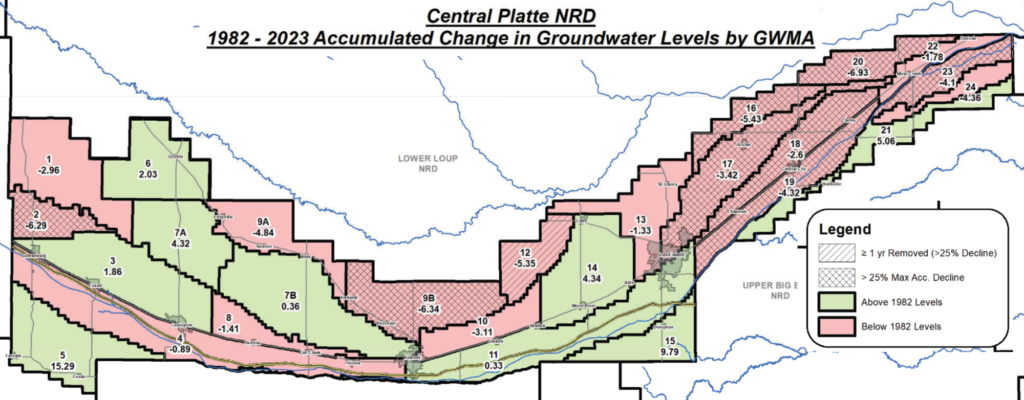Groundwater Quantity Management Program
Central Platte NRD’s Groundwater Quantity management goal is to assure an adequate supply of water for feasible and beneficial uses through proper management, conservation, development and utilization of the District’s water resources. CPNRD collects groundwater level observations and administers programs for irrigation runoff, groundwater quantity and quality modeling. CPNRD is developing a surface water flow model for a comprehensive groundwater and surface water management program.
The Groundwater Management Plan was updated in May and took effect on July 1, 2023. The Rules & Regulations were approved at the November Board meeting to align with the updated Plan and effective December 24, 2023.
Statewide Groundwater Management
Nebraska leads the nation in irrigation production with over 8 million irrigated acres. Being in the Platte River Watershed, the District’s primary surface water feature is the Platte River. However, most farmers rely on groundwater for their irrigation needs since groundwater is abundantly available across the District. Water supply is under continuous monitoring throughout the District and a groundwater supply management plan to address potential shortages has been adopted by the NRD’s board of directors and has been in effect since 1987.
Groundwater aquifer declines have been documented where irrigation use is the heaviest. Groundwater is the District’s chief source of drinking water and primary economic resource of the NRD since we depend on it for irrigation; which, in turn, enables us to have a strong economy rooted in agriculture. If there was any doubt that we need to take care of this resource, it should’ve been dispelled by declining water tables in the late 1970s and early 1980s. Rainfall increased in the mid-1980s/1990s, which caused water tables to rise, but the historical record suggests complete groundwater recovery from the dry periods during the wet periods does not always occur in all areas. Careful management of the resource is necessary. Aquifer thickness varies from 25-300+ feet across the district, so a drop of one foot has a more significant impact on some parts of the District than on others. Groundwater depths and thicknesses are charted and used to help establish 24 groundwater supply management areas. Besides the aquifer conditions, the soils and topographic characteristics are similar in each management area.
The 1982 groundwater levels were established as the standard for the management plan since rainfall and recharge were above average several years since 1982. The maximum acceptable decline for each of the management areas was calculated, establishing a margin of safety in each area. It was determined that as an area’s average groundwater level declined through that margin of safety, certain controls ought to be mandated to slow the decline.
In 1987, the board established the Groundwater Management Plan with a phased program to implement controls when needed. The maximum acceptable decline ranges from 10’ in the eastern end of the District to 30’ in portions of the western end of the district. If the water table falls to 50% of that maximum decline (5 and 15 feet respectively for each of the range parameters), Phase II would go into effect for any area or areas affected, triggering mandatory reductions in irrigated acres and establishing spacing limits for new irrigation wells. Further declines to 70%, 90% & 100% of the maximum acceptable decline will trigger Phase III, IV and V controls respectively, mandating additional cutbacks in irrigated acreage and increased spacing limits for new wells.
Complete details of the controls are available in district publications. Because of the differences in the aquifer depth and conditions, it is conceivable that some areas could be in the higher phases while other areas may always be in Phase I.

Fall 2023 Report
Of the 386 wells read from spring 2023 to fall 2023, 311 declined an average of 2.80 feet. Zakrzewski said the annual drawdown from the irrigation season was expected. Precipitation in the western area of the district aided in increases in 55 wells at an average of 3.44 feet. A fall-to-fall comparison of 377 wells read from 2022 to 2023 showed that 263 wells had declines averaging 1.52 feet. 114 wells increased an average of 1.48 feet. Fall readings are not used in groundwater management decisions.
Spring 1982 – Spring 2023
The spring 2023 static groundwater levels showed declines in all 24 GWMAs within CPNRD compared to the groundwater levels in 1982. There were 376 wells, 4 wells per township, were included in the assessment. The entire District had an accumulated loss of -1.30 feet and -0.80 feet since 1982. Four of the GWMAs (2, 16, 17, 18) triggered below 25% decline. Three GWMAs continue to show declines and are under additional management restrictions :
- GWMA 9 is down 1.18 ft. from the previous year (-9.06 ft. to -10.24 ft)
- GWMA 16 is down 3.26 ft. from previous year (-2.17 ft. to -5.43 ft.)
- GWMA 20 down 2.15 ft. from previous year (-4.78 ft. to -6.93 ft.).
Subdivision Reassessment
The boundaries for Sub-Areas 7a, 7b, 9a, and 9b were reassessed in August 2023 for the CPNRD’s Groundwater Management Program. The Board subdivided Groundwater Management Areas 7 and 9 in the updated Groundwater Management Plan due to differences in irrigation development that have occurred in the two areas and to address groundwater levels in parts of those GWMAs that have some decline concerns. The original management plan and boundaries were developed using surface topography, soils, aquifer-saturated thickness, and government boundaries (section lines, county boundaries, etc.). 2,853 wells, including 113,000 readings for static water levels, were used to reassess the new sub-areas.
in May 2023, the Board approved updates to both the water quantity and water quality portions of the Plan; which became effective on July 1, 2023.
Changes to the water quantity section include:
Phase I - Trigger changed to a range of 0-25% of the Maximum Acceptable Decline (MAD).
Phase II - Applies to any area with declines greater than 25% of the MAD.
Phase III - Changed to 50% decline in water levels relative to the MADs.
Phase IV - If water levels in a given GWMA continued to decline and reached 75% of the MAD.
Phase V - Implemented if Phase IV MAD is 100% reached or exceeded.
The preferred option for groundwater quantity management controls related to each phase is measuring devices and a limit on the volume of groundwater pumped.
Phase I - No additional management requirements.
Phase II - Remains as is with limitations on transfers and supplemental wells.
Phase III - When trigger is reached, measurement devices required on all active irrigation wells in the GWMA, and the owner/operator of every active well required to report annual water usage to the NRD.
Phase IV - When trigger is reached, CPNRD will allocate groundwater use to prevent the GWMA from reaching the MAD.
Phase V - If initial allocation is insufficient to prevent reaching the MAD, and that MAD is reached/exceeded, it would require a reduction of the allocation.
YOUR CONTACT: Luke Zakrzewski, GIS Image Analyst
2023
WaterSMART Grants Resolutions were approved to submit for the U.S. Bureau of Reclamation’s WaterSMART Water & Energy Efficiency and Small-Scale Water Efficiency grants. The projects will address irrigation efficiency on the three canals CPNRD partners with and meter approximately 100 wells to support COHYST data on average annual irrigation amounts in the CPNRD. The resolutions include:
* Small-Scale Water Efficiency Grant - Thirty-Mile Irrigation District Canal Efficiency Project
* Water & Energy Efficiency Grants (3) - Southside Irrigation District/Cozad Ditch Company Flow Measurement, Canal Efficiency Project and the Flowmeter, Telemetry & Data Management System Project
Updates to CPNRD's Groundwater Management Plan
1) Water Quantity Phase I trigger changed to a range of 0-25% of the Maximum Acceptable Decline (MAD). Phase II applies to any area with declines greater than 25% of the MAD. Phase III changed to 50% decline in water levels relative to the MADs. If water levels in a given GWMA continues to decline and reaches 75% of the MAD, the GWMA would be at a Phase IV level. A Phase V designation would be implemented if that MAD is 100% reached or exceeded.
2) The preferred option for groundwater quantity management controls related to each phase is measuring devices and a limit on the volume of groundwater pumped. Phase I has no additional management requirements. Phase II remains as is with limitations on transfers and supplemental wells. When the Phase III trigger is reached, measurement devices will be required on all active irrigation wells in the GWMA, and the owner or operator of every active well will be required to report annual water usage to the CPNRD. At the Phase IV trigger, CPNRD would allocate groundwater use to prevent the GWMA from reaching the MAD. If the initial allocation is insufficient to prevent reaching the MAD, and that MAD is reached or exceeded, this would trigger a Phase V designation, requiring a reduction of the allocation.
3) Ground Water Management Areas 7 and 9 were subdivided due to differences in irrigation development that have occurred across those GWMAs.
4) Water Quality Phase Triggers
Phase I: 0-7.5 ppm, Phase II: 7.6-10.0 ppm, Phase III: 10.1 ppm & above. Phase IV: An area where nitrate concentrations are not decreasing.
10-Year Meter Program Brandi Flyr, Hydrologist Ph.D., reported the results of CPNRD’s 10-Year groundwater pumping study that included 78 sites district-wide showed that producers are pumping less water than estimated. The program provided flow meters equipped with telemetry, soil probes and weather stations to producers with the goal of collecting raw pumping data. The program was designed to be voluntary, allowing producers to review their own pumping data and adjust their water use as needed. Flyr showed examples of sites where producers used the data and reduced their water use without impacting yields. The NRD has applied for funding to continue the study through 2034. Flyr said the results will be added to the NRD’s groundwater models to account for water uses and integrated into the Robust Review water accounting budget.
NRD App Agreement Agreement approved with Longitude 103 of Brush, Colorado, to develop an NRD software app in the amount of $38,000. The agreement cost includes the first-year annual service fee and professional services to migrate Central Platte NRD’s current data.
Observation Well Bids Agreement approved in the amount of $53,322.85 from Downey Drilling of Lexington, Nebraska, to construct 13 dedicated observation wells in Merrick County and the eastern portion of the Central Platte NRD. CPNRD staff measures 450-500 wells throughout the District each spring and fall to monitor groundwater levels as part of the Groundwater Management Program. The new wells will replace irrigation wells that are no longer accessible to measure.
Platte River Resilience Committee David Carr, Range Management Specialist, selected to replace Deb VanMatre as Central Platte NRD’s representative on the Platte River Resilience Committee that manages Phragmites control along the Platte River.
Platte River Recovery Implementation Program (PRRIP) David Carr selected to replace Lyndon Vogt on the PRRIP Land Advisory Committee.
Central Platte/Tri Basin NRDs Joint Executive Meeting The two NRD committees met on March 13th in Kearney to discuss the Central Nebraska Public Power & Irrigation District excess flow agreement, Nitrogen Dashboard/Longitude 103, and recent cost-share programs approved by both districts.
Violation Report Luke Zakrzewski, GIS Image Analyst, reported that he has been working with the 56 landowners/producers who received a violation notification in February on land that was irrigated without proper certification or through a transfer. He reported that 11 are now in compliance with the NRD’s Groundwater Management Program and the remaining are planning to complete required paperwork.
2022
Water Service Agreement An amended water service agreement was approved in the amount of $1.2 million with the Nebraska Department of Natural Resources (NeDNR) and Tri-Basin NRD at their monthly meeting on Thursday. The agreement allows the NeDNR to pay Central Nebraska Public Power & Irrigation District (Central) $19,100,000.00 in advance to divert water into the E-65 Canal, Phelps Canal, Elwood Reservoir and various waterfowl production areas to provide aquifer recharge for 15 years. Central Platte NRD will receive credit for 25% of the excess flows (500-2,500 AF/year) that will provide seepage back to the Platte River. The $1.2 million was being held at the Nebraska Community Foundation.
Violation Report CPNRD uses infrared imagery flown each summer to examine fields for violations. 2022 remaining violations include: A Polk County landowner has three offenses for irrigating non-certified irrigated acres and was sent Cease and Desist orders. The landowner had violated a prior Cease and Desist Order and a court order to cease irrigation until getting into compliance with CPNRD’s Rules and Regulations. That individual will be sentenced for the unresolved violations. A tenant/landowner miscommunication regarding NRD reports has been rectified and should be resolved going forward. Two other producers that violated Cease and Desist orders filed by CPNRD are now in compliance with the NRD’s Groundwater Management Rules and Regulations. Penalties as a result of the violations will be enforced.
Schroeder Property John Peterson, JEO Consulting, presented management options to maximize the hydrologic benefits for a 151-acre property in Dawson County, purchased in April 2018, to the Water Utilization Committee. The current renter will be charged $125/acre to lease as dryland and the NRD will retire the irrigated acres to gain credit for 107 acre-feet (AF) of water back to the Platte River starting in 2023. The Utilization Committee will review and determine which of the management options presented will best meet requirements of the Integrated Management Plan, the Basin-Wide Plan for Integrated Water Resources Management for over-appropriated areas in the Platte River Basin, and Nebraska’s New Depletions Plan.
Groundwater Management Plan Jim Schneider, Olsson Engineering of Lincoln, gave an update to CPNRD's Board of Directors on the rewrite of the NRD’s Ground Water Management Plan in June. In July, the Water Utilization and Water Quality committees reviewed updates to the NRD’s proposed Ground Water Management Plan and approved sending the Plan to the Nebraska Department of Natural Resources for review. Public information meetings will be scheduled when the Plan is completed. In 2019, Olsson was selected to rewrite the Plan and incorporate new data and insight acquired since the approval of the plan in 1985. The original Ground Water Management Plan was based on hydrogeologic, climate and socio-economic information available at the time. CPNRD has since acquired and developed significant data about the groundwater resources. Over the last 37 years, rules and regulations have changed significantly and groundwater management goals have evolved to satisfy requirements of the CPNRD’s Integrated Management Plan, the Upper Platte River Basin Plan and the Platte River Recovery Implementation Plan. Olsson updated plan triggers, data sets and maps, and completed over 200 scenarios with new data from the 2022 Cooperative Hydrology Study model (COHYST) to predict 50-year simulations. The updated plan includes changes to allow subdistricts to be subdivided for independent management within the area, new maximum acceptable decline triggers; and additional management regulations to require meters and allocation to address groundwater decline instead of cutting irrigated acres. The water quality portion of the plan was not changed.
2020
Invasive Weed Management CPNRD will invest $500,000 over three years in an endowment for the Platte Valley Weed Management Area (PVWMA) to fund the annual cost of maintaining water conveyance in the Platte River. Since 2009, the PVWMA has treated approximately 26,000 acres of invasive plant species within flowing channels of the Platte River in Dawson, Buffalo, Hall, Merrick, Hamilton and Polk counties within the NRD.
Violation Report 12 landowners/producers irrigated land that isn’t certified or approved for irrigation through a transfer in 2019. The number of violations has continued to drop each year. Violation letters were mailed to resolve the violations. If the land continues to be irrigated without certifying the acres in question, a cease and desist order will be issued and violators could face action in District Court.
2019
Recharge Agreement A recharge agreement with the Nebraska Community Foundation for the Platte River Recovery Implementation Program changes the way the CPNRD is paid for groundwater recharge via seepage through the Six Mile, Cozad, Thirty Mile, and Orchard Alfalfa canals in the non-irrigation season. The total amount of diverted will be measured by CPNRD using automated measuring and recording gates and adjusted by subtracting any deliveries or releases made and recorded by the irrigation district. The non-irrigation season will begin when the canals stop releasing water for irrigation and end when the canals begin releasing water for irrigation as determined by CPNRD.
Policy Changes to the Groundwater Management Plan (as of November 2018)
*Irrigation New wells that irrigate new acres are not allowed. Supplemental & replacement wells are still allowed.
*Transfer Schedule Transfer applications for irrigated acres will be accepted from September 1- March 1.
*Sub-Area Transfer A sub-area is required to stay under the transfer limit rule for 5 consecutive years. Transfers & supplemental wells are not allowed until the sub-area groundwater level exceeds 25% of the maximum acceptable decline.
-
Main Office
- 215 Kaufman Ave, Grand Island, NE 68803 308-385-6282
-
Cozad Office
- 75887 Road 414, Cozad, NE 69130 308-380-8943
-
NRCS Field Offices (Ext. 3)
- Central City 308-946-3035
- Kearney 308-237-3118
- Grand Island 308-395-8586
- Lexington 308-324-6314
- Osceola 402-747-2461




